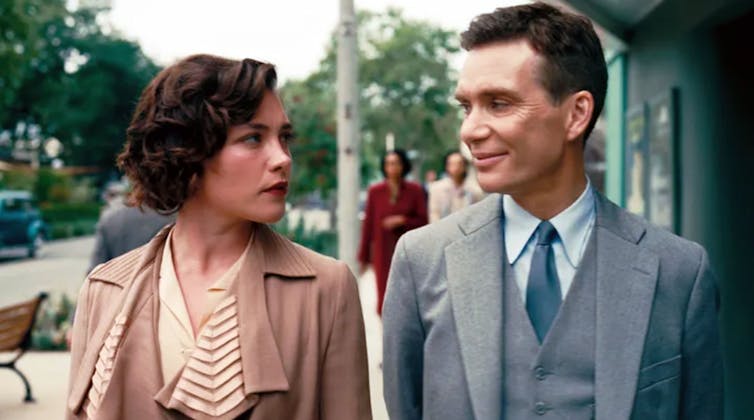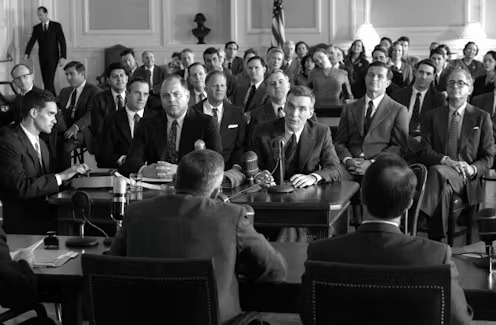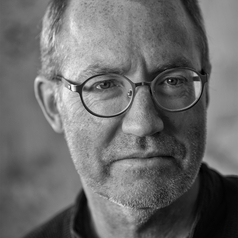As part of the research for “Hiroshima Nagasaki: The Real Story of the Atomic Bombings and Their Aftermath”, published in 2013 by Penguin Random House (UK) and Pan Macmillan (US), author Paul Ham interviewed 80 survivors of the 1945 atomic bomb attacks.
The ghost of a little Japanese girl attended the Oscar celebrations last week. Nobody noticed her. She sat in the wings, her face seared, her blood poisoned, her skin marked after countless grafts, her mind scarred by the memory of the events in Hiroshima on 6 August 1945. They were the direct result of the work of J. Robert Oppenheimer. The Academy Awards was celebrating the film version of his life – it took home seven Oscars – yet it dismally failed to address his decisive role in the decision to drop the bomb, and all the death and destruction it caused.
Choosing the target
In May 1943, a high-powered “target committee” agreed a shortlist of five Japanese cities as suitable targets for a terrifying new weapon that drew its power from an atomic chain reaction. Oppenheimer, the scientific leader of the Manhattan Project, then building the weapon at the Los Alamos Laboratory in New Mexico, co-chaired the committee. He ran through the agenda like an executive attending a board meeting: “height of detonation”, “gadget [bomb] jettisoning and landing”, “psychological factors in target selection”, “radiological effects”, and so on.
Kyoto and Hiroshima headed the target list because they were “large urban areas” capable of being “extensively damaged” or that they had great “sentimental value” to the Japanese (Tokyo had been rejected because it was “rubble”). Kyoto was the preferred target “from the psychological point of view” because the ancient city was an “intellectual center” and that its then 1 million residents were “more apt to appreciate the significance of such a weapon,” the committee noted. However, Hiroshima’s “adjacent hills” were “likely to produce a focussing effect which would considerably increase the blast damage” – that is, the hills would concentrate the blast waves on the people. Hiroshima was chosen as the target.
Official trailer for Oppenheimer (2023), directe by Christopher Nolan.
The desired “spectacular” impact
The weapon created by Oppenheimer’s team exploded directly above Shima Hospital, in the centre of Hiroshima, at 8:15 a.m. on 6 August 1945, instantly killing all patients, doctors, nurses, and visitors in the building. Those who saw the flash did not live to experience their blindness. The heat wave charred every living thing within a 500-metre radius and scorched uncovered skin at 2 kilometres. The instantaneous ground temperature ranged between 3,000 and 4,000 degrees Celsius, hotter than the surface of the sun (iron melts at 1,535 degrees Celsius). About 70,000 civilians were killed instantly.
There was no mass panic. The people of Hiroshima had had no warning; they were not prepared to panic. Shock turned to stupefaction, then to a soft and insistent plea: “It hurts”, “Help me”, and “Water, water”. Hysteria was individual, the expression of acute, private grief. The sudden sight of the charred remains of their children induced madness in uncomprehending mothers, who wandered in circles, holding their dead offspring to the sky. Or they clung fast to the little bundle as if that might bring the child back to life.
Three days later, on 9 August 1945, an American plane dropped another atomic weapon, this time on Nagasaki. The plutonium bomb created by Oppenheimer’s team missed its target – the city centre – and instead detonated above the main cathedral in the hospital and schools district. It was home to Nagasaki’s 12,500 Catholics, and 8,500 were killed instantly. In total, the two weapons killed about 100,000 civilians on impact (the same number who perished in the Tokyo firebombing raids on the night of 9-10 March 1945). A further 250,000 would die of bomb-related cancers.
The film purporting to be the life of the man who invented the atomic bomb mentioned none of this.

Florence Pugh and Cillian Murphy in a scene from Christopher Nolan’s Oscar-winning film Oppenheimer. Melinda Sue Gordon/Universal Pictures
Looking away
Instead, Oppenheimer devotes most of its second half to an interminable assessment of whether his security clearance should or should not have been renewed after the war. As though his career was all that mattered. There are flashbacks to his utterly irrelevant affair with a communist, engaged in many years earlier, offering the viewer gratuitous sexual content, little more.
The film completely overlooks Oppenheimer’s intimate involvement in how the bombs were used, and where. He personally recommended a nuclear strike on the centres of two cities populated overwhelmingly by civilians, without warning. That happened. As for the rest of his life, it was filled with wistful dreams about arms controls that were neither heard nor enacted.
The film relegates the Japanese to a footnote, which is entirely in keeping with Oppenheimer’s view: he never once expressed regret for what his creation had done – indeed, he never visited Japan. When Oppenheimer told President Truman that he had “blood on his hands” he didn’t mean that of countless thousands of Japanese civilians who died, he meant the blood of future generations who would die in a coming nuclear holocaust for which he felt responsible.
The only victims of the bomb presented by this film were American students who are seen dying, their skin melting, as they listen to a lecture – but they exist only in Oppenheimer’s imagination. The historical victims of this atrocity, the Japanese people, were airbrushed out of the narrative.
Some critics have suggested that leaving the horror of Hiroshima and Nagasaki out of the film was a “sensitive” choice by the director, Christopher Nolan, because his film was only “entertainment” and “a fiction”, yet Nolan bills the film as having been based on the Pulitzer Prize-winning book American Prometheus by Kai Bird and Martin J. Sherwin. Instead, his decision to leave the bombing of Japan out of the film seems more of a financially astute decision – the reality wouldn’t have pulled in the crowds, nor attracted awards.
Hollywood is good at portraying the horror of genocide and war crimes so long as the perpetrator isn’t the United States. Yet in Hiroshima and Nagasaki, American actions were directly responsible for the instantaneous death of 100,000 civilians, including 8,500 schoolchildren.
The film purporting to be the life of the man who invented the atomic bomb mentioned none of this.

On 9 August 1945, American forces dropped a plutonium bomb on Nagasaki. The plane missed the city centre and instead detonated above the main cathedral in the hospital and schools district. Getarchive.net
In 2009 I visited an aged care home in the suburbs of Hiroshima built exclusively for hibakusha – the “bomb-affected people”. The patients were having lunch as the doctor and I entered. The upward gaze of the ward seemed to hold a measure of surprise at the sight of a Westerner, the first some might have seen since 1945 – “Why is he here, to study us?” their eyes seemed to say. Some had no outward physical signs of bomb exposure, yet were psychologically damaged, mute and expressionless. Others were deformed, their bodies twisted and faces scarred. One or two waved from their wheelchairs, smiling. The effort lent a strange sense of hope, that nobody here takes for granted the use of their hands or the movement of their lips. A source of happiness here was simply being able to smile.



 The Mona Lisa is a vampire
The Mona Lisa is a vampire  Disney’s ABC Pulls Jimmy Kimmel Live! After Controversial Remarks on Charlie Kirk Killing
Disney’s ABC Pulls Jimmy Kimmel Live! After Controversial Remarks on Charlie Kirk Killing  Asian Fund Managers Turn More Optimistic on Growth but Curb Equity Return Expectations: BofA Survey
Asian Fund Managers Turn More Optimistic on Growth but Curb Equity Return Expectations: BofA Survey  Oscars 2025: who will likely win, who should win, and who barely deserves to be there
Oscars 2025: who will likely win, who should win, and who barely deserves to be there  FCC Chair Brendan Carr to Face Senate Oversight After Controversy Over Jimmy Kimmel Show
FCC Chair Brendan Carr to Face Senate Oversight After Controversy Over Jimmy Kimmel Show  Trump Faces Mixed Reception at Kennedy Center Amid Conservative Overhaul
Trump Faces Mixed Reception at Kennedy Center Amid Conservative Overhaul  Gulf Sovereign Funds Unite in Paramount–Skydance Bid for Warner Bros Discovery
Gulf Sovereign Funds Unite in Paramount–Skydance Bid for Warner Bros Discovery  Google and NBCUniversal Strike Multi-Year Deal to Keep NBC Shows on YouTube TV
Google and NBCUniversal Strike Multi-Year Deal to Keep NBC Shows on YouTube TV  Disney Investors Demand Records Over Jimmy Kimmel Suspension Controversy
Disney Investors Demand Records Over Jimmy Kimmel Suspension Controversy  Netflix’s Bid for Warner Bros Discovery Aims to Cut Streaming Costs and Reshape the Industry
Netflix’s Bid for Warner Bros Discovery Aims to Cut Streaming Costs and Reshape the Industry 
































